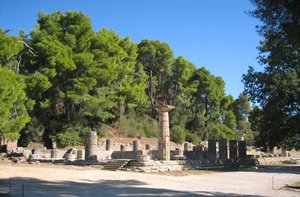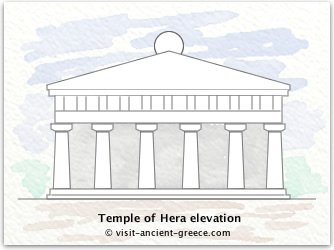The Temple of Hera was one of the oldest buildings in the site of Olympia. After the first games had been organized in 776 BC, they gradually became more important throughout the Greek world.
The first buildings erected were small and simple, with none of the sophistication displayed in later centuries.
The first temple
It was during the middle of the 7C BC that work began on the Temple of Hera. Initially it was a fairly small structure, about 10m by 40m. In about 600 BC an opisthodomos was added, together with a ring of columns.
The final dimensions of the temple were 18.75m by 50m, substantially larger than the original. By later standards it was long and narrow, and looked rather squat and heavy (see the illustration below). But the temple is important, because it is one of the oldest examples of monumental temple construction in ancient Greece.

Materials used
If you’ve seen the Parthenon at Athens, you might think that all Greek temples were constructed using marble. But this was only possible if there was a good source for the marble, that there was a way of transporting it to where you wanted to build your temple, and you had the means to pay for all of this work.
In the early years of Greek temple building when they were developing their style of architecture and wealth was not widespread, they use local materials for building. The Temple of Hera was made using local limestone, with upper parts of the walls made from unbaked brick. The entablature was mostly made of wood, covered with terracotta, and the roof tiles were also of terracotta.
The columns of the Temple of Hera were originally made from wood. Around the end of the 7C BC there was a rapid development in building techniques. (One theory is that the Egyptian king Psamtik 1st regained control of Egypt from the Assyrians in about 660 BC. Because of trading contacts the Greeks would have seen the building works which were begun, and learned about monumental stone constructions.) When columns needed replacing because of war, earthquakes, or the wood started to rot, stone columns were used. They also used column styles which were in fashion at the time. When Pausanias visited Olympia in the 2C AD there was a column of oak in the opisthodomos.

Inside the Temple of Hera
In the naos (or cella) there is the pedestal where the cult statue of Hera once stood. She was seated on her throne with Zeus standing by her side. Unfortunately only the head of Hera has survived.
A number of other items important to the ancient Greeks were believed to have been stored in the temple. These included a bronze disk belonging to Iphitus, and a carved ivory chest in which Cypselos was supposed to have hidden. Pausanias describes the chest in detail.
Other valuable offerings were stored in the Temple of Hera. In later years it housed the famous Hermes of Praxiteles (which you can see in the museum).
The temple stood for about a thousand years until the late 3C AD.

What you can see today
Some of the columns have been re-erected, and this gives added interest to the site. You can see the columns are not very tall, and would have given the temple a low, squat appearance (see the illustration of the elevation). You can get a very good idea of how it would have looked from the models in the museum.
